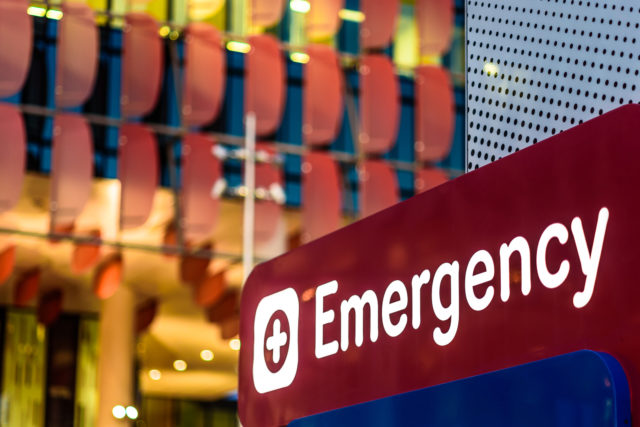
Visit volumes within hospital emergency departments (ED) have skyrocketed, leading to long wait times, and burnt-out emergency department (ED) providers, and staff, adding incredible stress to an already challenged healthcare system.
Many factors contribute to these conditions, one of the primary being that ED visit volumes depend heavily on location. Local hospital closures, for instance, drive more patients to flock to larger ED locations that may be further away, driving up visit volumes drastically. Since 2005, 180 rural U.S. hospitals have closed, and nearly 1,000 more hospitals face similar fates. Hospital closures exacerbate challenges for rural communities already coping with population loss, economic decline, and rising rates of suicide and substance use – adding further strain to available care facilities. Acute workforce shortages, in addition to ED boarding availability, also negatively affect the throughput of patients, causing further delays in care availability.
Patients consistently overlook urgent care (UC) as a viable option, leaving them with fewer care options while emergency departments struggle to manage demand and challenges created by overcrowding. There has been an increase in ED usage for healthcare that is not considered emergent or life-threatening – the exact use cases where UC thrives. Although it is the patient’s prerogative to select their avenue of care, the issue partially stems from a lack of patient knowledge on what services are offered across facilities whether that be hospitals, EDs, UC, or other care sites.
Before the Covid-19 pandemic, UC served patients presenting with an extensive scope of injuries or illnesses requiring immediate care, but not serious enough to require an ED visit. The pandemic shifted UC priorities for both patients and providers, causing respiratory illnesses to become the primary reason for UC visits. The focus on Covid-19 testing and treatment was beneficial for UC from a business standpoint in the short term. However today the drop in acuity and consistency of services along with decreased Covid-19-related visits, have resulted in negative effects.
Reinforcing the foundation for care
The UC industry can alleviate the stress put on EDs by helping providers and patients better understand how they are best suited to deliver urgent non-life-threatening care. To move beyond the pandemic lull, UC can internally focus on re-educating providers who may have lost touch with the higher acuity skill sets and track consistency in care. If half a clinic’s providers turn away a subset of patients, it confuses the patient population on where to go for care. UCs will also need to better inform the public when it comes to the services they offer that may have otherwise led the patient to an ED waiting room. Not only does UC offer services that can reduce the amount of ED admissions, but they also have the technology to seamlessly access patients’ medical records so visits are not prolonged with documentation and excessive intake forms.
Urgent care clinics must tout their accessibility and convenience, particularly in conjunction with their extended hours on weekdays and weekends. They also have more locations in underserved, rural, and low-income communities where EDs may not be present. Not only can patients be seen faster at a UC clinic with less time being spent in the waiting room, but their entire visit can match the efficiency of an ED with technology such as EHRs and teleradiology. Services at UC clinics are generally faster than most EDs, and patients are seen more efficiently. UC is also known to be cheaper according to a UCA stat claiming that ED visits are approximately 10 times more expensive than UC visits. Additionally, according to a Fair Health study, “in 2016, the median charge for a 30-minute new insured patient visit was $242 at an UC center, compared to a $294 visit in a primary care office, and a $109 visit in a retail clinic.” The UC industry prides itself on being able to provide efficient and quality care, and this core UC messaging should be reinforced to reduce the number of patients seeking care at an ER.
A proactive approach
Urgent care clinics must proactively communicate to the public the services they offer, and why they might be better suited to address certain concerns than an emergency department. An ED, for instance, is for life-threatening conditions, whereas UC is typically for episodic care and low acuity conditions. UC is also a great place to get referrals and understand how to navigate the medical system efficiently. Most UCs know the best specialists in the area and can arrange for specific follow-up, a service most EDs don’t offer. Sharing these differentiators with the patient population through various channels of marketing will help to create a clearer division of where they can and should go to seek care that best suits their needs. UC can also supplement or even replace a primary care practitioner if the patient does not have one, so they can still receive regular, or annual care for their general well-being. The breadth of UC services also extends to x-rays, EKGs, and a variety of labs. Patients must understand this thoroughly if they are going to instinctively turn to UC instead of an emergency department when their health is affected.
Crowded EDs will continue to plague the healthcare ecosystem and prevent the efficient delivery of care if the structure and education of care, resources, and availability are kept the same. UC can step in with its well-equipped and trained staff so that EDs can focus on what they do best, care for life-threatening situations. Once a balance is established among patients regarding where to seek proper care for their medical needs, there will be less tension within the healthcare ecosystem, leading to reduced burnout from providers and more satisfied patients walking away with positive outcomes.
Photo: Adam Calaitzis, Getty Images








